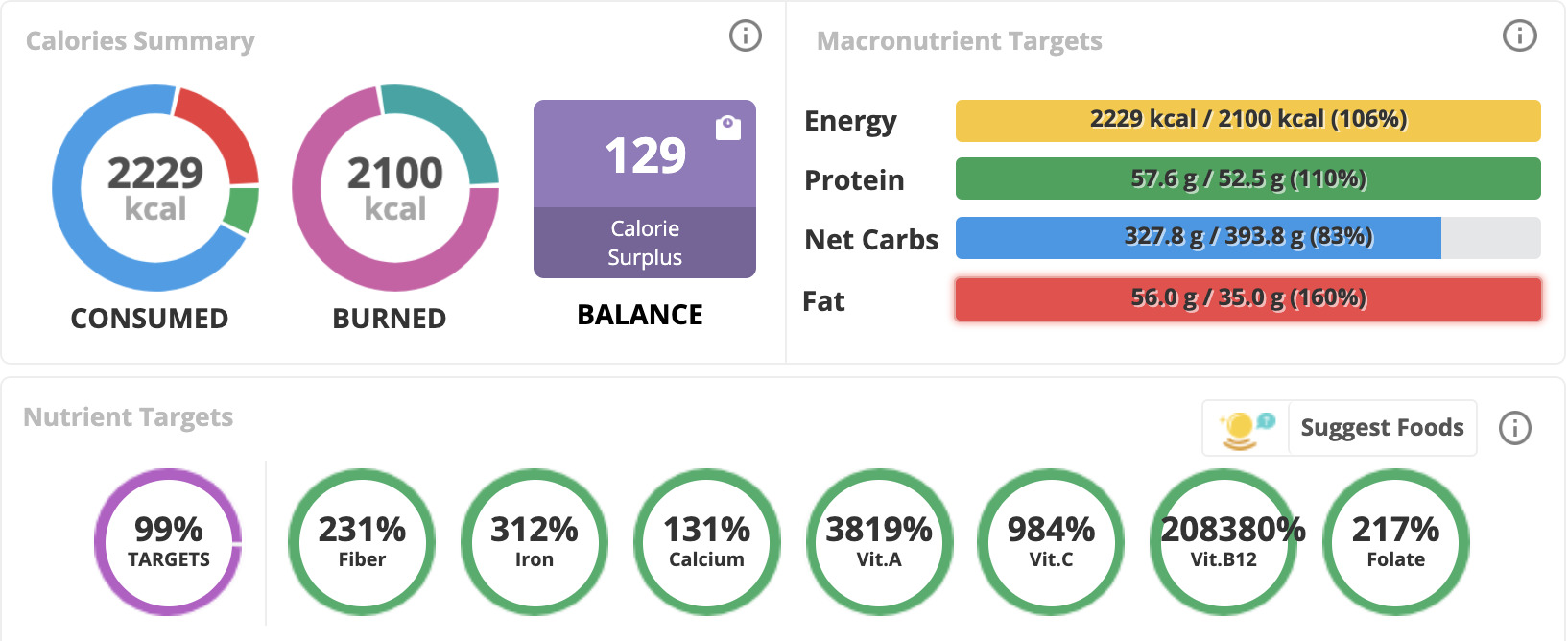Summary: In April-May 2019, I was inspired by the New Diet System by Shri B V Chouhan from Gujarat, India. In June 2019, a conversation with Dr Goldhamer from Santa Rosa, California, infused confidence in me that such a system was nutritionally complete. I then played around with Cronometer to figure out what foods to consume to get all micro- and macro-nutrients known to science so far.
My goal was to figure out a practical, food system that could be sustained for a long time (ideally, forever)! So it should be convenient to get all ingredients, prepare my meals, and enjoy eating them! For the sake of experimentation, I am willing to consume not-so-tasty meals but for the long term, I need foods that are really delectable, so that I look forward to my lunches, snacks and dinners!
I live in a modern, large city in California. Luckily, we have a lot of grocery stores nearby with excellent food choices. And we have online stores like Amazon! So ingredients were not a problem at all.
In my professional life, I am a computer scientist at a large company. And I'm not a foodie. I can live with plain and simple meals. I kinda strive for minimalism and simplicity. The idea of not having to cook at all appealed to me: less work! The idea of having to visit only the produce section for fruits, vegetables, herbs was also appealing! Occasionally, I'd have to visit the bulk section of grocery stores to pick up various nuts and seeds.
In June 2019, I attended a 1-day seminar on wellness organized by ICC Milpitas. I chatted with Dr Goldhamer, director of TrueNorth Health Center, Santa Rosa, CA.
Dr Goldhamer advocates WFPB SOS-Free (WFPB with no Sugar, no Oil, no Salt). I asked Dr Goldhamer, "Can we eliminate grains and beans from WFPB-SOS and have a nutritionally complete system?" To my surprise, he said, 'Yes!' Turns out that every known nutrient is found in this subset of food components: {fruits, vegetables (especially leaves and tubers (root vegetables)), herbs and spices, nuts and seeds, water}. Processed foods, meats, dairy, salt, oil, sugar, grains, beans: all of these may be eliminated! Wow! That's exactly what NDS (New Diet System) encourages us to follow!
Dr Goldhamer mentioned that B-12 is unavailable in the modern world because modern food storage and food handling techniques are 'ultra-clean', so we become B-12 deficient. Otherwise, even B-12 would be also be available in the food components mentioned above. Additionally, we may need Vitamin D supplementation if we are deficient (Vitamin D is produced by skin exposure to sun; some of us cannot produce enough in certain latitudes).
I also asked Dr Goldhamer, 'Why are grains and beans listed in every nutrition book?' He replied, 'Because they are cheap! If we move to veggies and fruits, our food cost will increase significantly. The cheapest foods are rice and beans.'
Inspired, my next step was to enter all of my foods into an app called Cronometer and figure out if I was getting all the macro- and micro-nutrients in adequate amounts.
My conversation with Dr Goldhamer convinced me that I ought to consume a large number of vegetables every day. I should not gorge on fruits alone and become a fruitarian and I should not gorge too many nuts & seeds (such a food system becomes 'high fat'). The requirements that vegetables ≫ fruits ≫ nuts & seeds presented a unique challenge: it's hard to consume so many vegetables raw!

Sweet Potatoes! Most veggies are also juicy! So my stomach fills up quickly by consuming only a few hundred calories of juicy veggies! So I gravitated towards 'calorie dense' veggies like potatoes (see this article: The Potato Hack, which explains that potatoes have been the cornerstone of diets of some cultures in the world, including the Okinawans, one of the Blue Zones cultures). Also, sweet potatoes may be eaten raw.
But eating 4 medium sweet potatoes raw takes a long, long time! So I gravitated towards steaming both potatoes and sweet potatoes. Steamed food can be consumed quickly and makes the system I chalked out practical. I consume all other veggies raw.
At the time of writing, I've started experimenting with sprouted {amaranth, buckwheat, quinoa} to reduce my sweet potato consumption.
Bitter & pungent vegetables: At some point, I was eating raw vegetables in their raw form! This way, I enjoyed each vegetable individually and I was able to figure out which vegetables I really liked! This process also helped me figure out that I don't like bitter or pungent vegetables like bok choy, cabbage, kale, collards and brussel sprouts. All of these are cruciferous vegetables with sulfur! I also don't like onions and garlic raw — both of these belong to the allium family. But if I mix these veggies with other veggies, the combination becomes acceptable for consumption. Examples: onions inside guacamole, or a shredded salad served on a giant collard leaf.
So I need to figure out: should I keep consuming these bitter or pungent vegetables by hiding their taste in mixtures of other vegetables? Or should I simply drop them from my food system? What's the best thing to do for long term health?
Summary: Eating raw salads with 900 calories of salads is challenging! It takes a lot of chewing. Getting 400 of these calories from steamed potatoes or steamed sweet potatoes makes the system practical. And I'm confused about bitter or pungent veggies: to consume them or to drop them?

The fruits listed above are basic fruits founds in California: bananas, apples, oranges and papaya. I knew that bananas, oranges and apples are great. Something new I learnt by using Cronometer was that papayas have a wonderful nutritional profile too! So I'll start consuming papayas regularly.
I also included 1/2 cup of berries because Dr Greger deems them very important. In his Daily Dozen checklist, an entire category is just berries! Now berries tend to be expensive — in California, we can get berries in bulk from wholesale stores like Costco.
How many fruits to eat? I would like to get approximately 700 calories from fruits daily. A rule of thumb for myself: each serving is approximately 100 calories. For 700 calories, I'd need about 7 servings of fruits daily.
Summary: Eat 7 servings of fruits (for about 700 calories total). Local and seasonal fruits are great! Simple fruits like bananas, oranges, apples and papayas are awesome! At least one of the 7 servings should be berries. But if berries are expensive, I chose not to worry.







I could not sustain a 100% raw vegan system that I experimented with in 2019. However, it was a huge learning experience. For example, I got to chew each and every vegetable individually to figure out what they actually tasted like! That itself was helpful to me — I can now intuit how to combine veggies to prepare something delectable.
In late 2019, I shifted to a "high raw" system in which the majority (upwards of 80%) of calories were derived from raw foods. The only cooked component in my food system was steamed / baked sweet potatoes. I knew that I could eat sweet potatoes raw but I never experimented with that.
Later, I shifted to a cooked food system and the percentage of raw foods decreated substantially.
Personally, I believe that raw food systems are great! I'm going to experiment with such a system again. They are a like a world of their own, with their own food combining and food timing guidelines! It would be fun to explore this world :-)

 Instagram
Instagram YouTube
YouTube